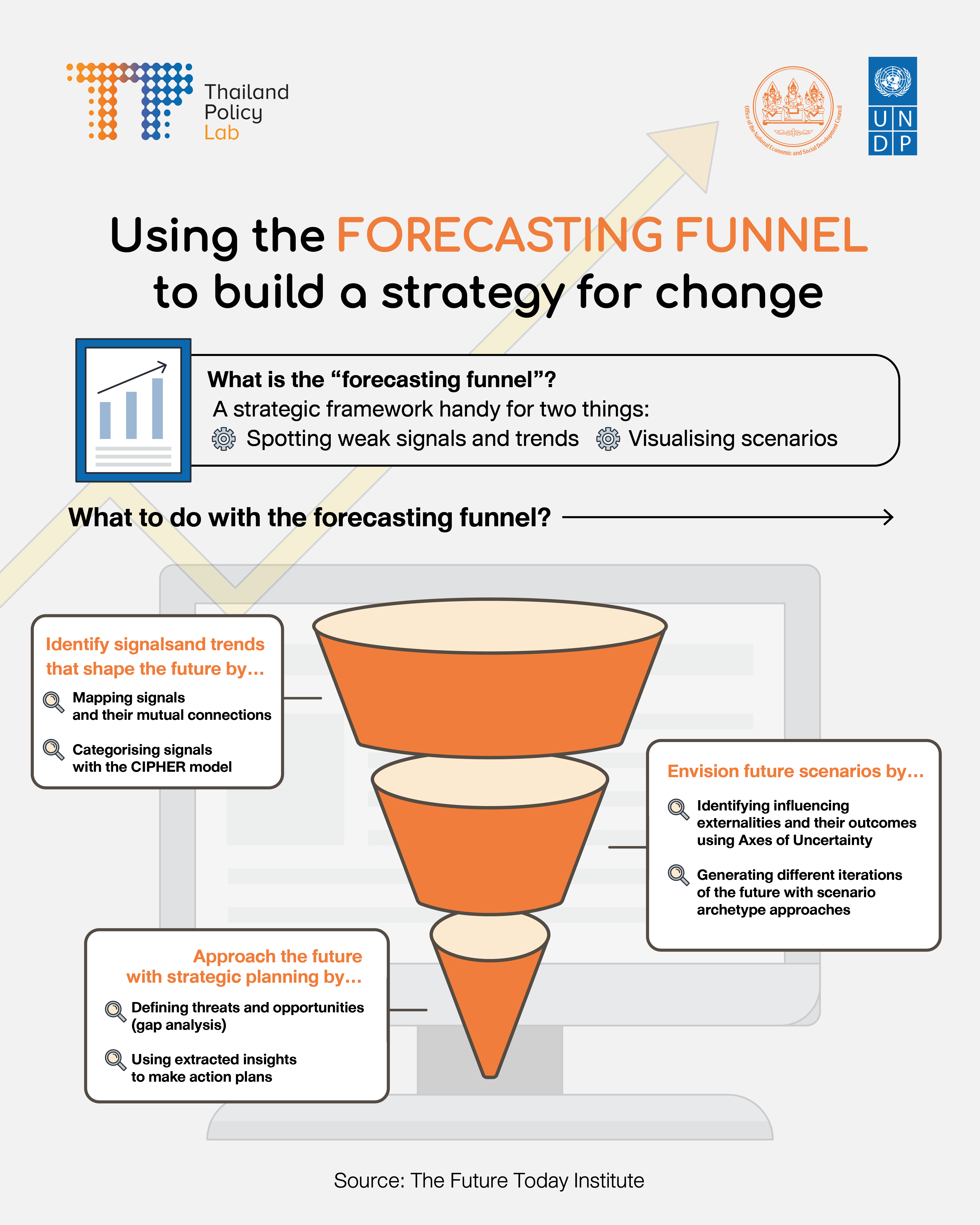It is not easy dealing with something you cannot physically see or touch like the future. Despite its elusiveness, however, there are clues of what it could become – signs that point towards a variation of risks and possibilities, emerging out of the present socio-economic, ecological, or technological phenomena. In this article, we will walk you through a journey of preparing yourself for change with a policy innovation toolkit called “forecasting funnel.”
Let’s get to know the forecasting funnel.
Informed by quantitative and qualitative data, the forecasting funnel is a strategic framework handy for two things: 1) spotting weak signals of change as well as patterns of trends, and 2) visualising possible scenarios that could play out based on the interaction between different signals. You can use it to create scenarios – revealing potential challenges and opportunities – or to strategize your next move.
The Future Today Institute suggests that Forecasting funnel can be divided into 3 major parts:
- Identify signals and trends that shape the future.
- Envision future scenarios.
- Approach the future with strategic planning.
1. Identify signals and trends that shape the future.
In this part, we will focus on signals, and extract our information about trends from our findings about them.
To explore signals, we can use a visualisation tool called a “Fringe Sketch” to project a spectrum of weak signals. Here, sources of disruption will be mapped out along with their connections to one another. This is to show a macro-micro overview of individual signals, and think about the impact of these webs of mutuality.

Source: Seton Hall University
In order to find trends among the intertwined string of signals, we can use the CIPHER model as a theoretical framework for identifying and grouping signals:
| Contradictions | When things that generally oppose one another fall into the same line of trajectory. Also, things that have been in harmony, but eventually diverge in different directions. |
| Inflections | When change is catalysed, resulting in a sudden occurrence of shifts in something. |
| Practices | Long-held practices and challenges to what has been normativized. |
| Hacks | When people “tweak” with something and use it in a way that it isn’t originally intended for. |
| Extremes | When people push boundaries to the point of change. |
| Rarities | A “black swan” event, or an anomaly in the system. |
2. Envision future scenarios.
The captured trends lay a solid ground for different sets of future scenarios. In this part, we begin by uncovering a wide array of uncertainties, or an amalgam of externalities that have a transformative impact on the future, as well as their implications. List and classify uncertainties from the trends in the past and present according to their nature, and map them by using a risk assessment tool called “Axes of Uncertainty.”

Source: The Future Today Institute
The axis is composed of a 2 x 2 matrix, with uncertainties from different categories placed on the opposite axes. Within this axis, describe events that could happen if uncertainties interact with one another:

Source: The Future Today Institute
What we are able to extract from the axis is a variety of rapid scenario prototypes, or a rough sketch of possibilities. To turn a flimsy idea of the future into substantial vision, enter “scenario archetype approaches.” These approaches sort scenarios with common trends, drivers, narratives, and assumptions into one broad category.
In general, there are 4 types of scenario archetypes:
- Continuation: The continuous growth of the status quo.
- Collapse: The system we live in experiences paralysis or downfall.
- Discipline: Measures to prevent collapse are introduced.
- Transformation: New orders, a new system, new ways of living that replace the previous ones.
You can use the aforementioned narratives as a classifier in a way you see fit, or make up your own versions of scenario archetypes.
3. Approach the future with strategic planning.
Now that scenario archetypes are in our hands, we can use them to inform our adaptation strategy. In this part, gap analysis is required in probing threats as well as opportunities that each scenario presents. Once you select the vision of the future you want to pursue, it is time to search for a route to take you there. Backcasting, another foresight tool, is particularly useful in this matter. Set a desired goal, then work backwards by identifying what you need to do or overcome in order to achieve the future.

Source: Roxi Nicolussi
And with concrete action plans to step forward, now you finally make weak signals become your strengths in face of the risky unknown!
Source: The Future Today Institute

